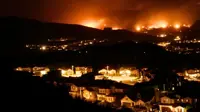Delhi smog: Kejriwal closes schools, bars diesel generators
07 Nov 2016
Cases of severe breathlessness, asthma and allergy have sharply risen in Delhi as the city remains blanketed in thick layer of toxic air due to the worst smog in 17 years.
Doctors and experts say that besides a spike in fresh cases, health complications have been aggravated in people having a history of asthma, allergy or other related ailments.
The sale of air masks has seen an upsurge in the past week with stores across the national capital and neighbouring regions running out of stock.
The Delhi government had ordered the closure of all schools for three days, but the Delhi State Public Schools' Management Association said public schools won't be closed over the pollution issue.
The government has further ordered that no diesel generator sets should be used in Delhi for the next 10 days except by hospitals and emergency establishments. Chief Minister Arvind Kejriwal has ordered the Badarpur power plant to be shut down for 10 days.
Vacuum cleaning of roads will start from 10 November, jet sprinkling of roads from Monday, and the government will bring back the odd / even car plying rule soon, Kejriwal said. Transportation of fly ash will also be stopped for 10 days, he said on Sunday.
The chief minister further said he will discuss with the Centre the possibility of engineering artificial rain.
All demolition and construction activities to be banned for five days, Kejriwal said.
Meanwhile, the demand for air purifiers has spiked with manufacturers such as Eureka Forbes, Blueair, Kent RO and Panasonic expecting up to a four-fold jump in sales.
The Delhi government has flagged crop burning in Punjab and Haryana as one of the major factors contributing to the rising air pollution in the national capital and said it peaks during the night hours due to low wind speed in comparison to daytime.
But experts say this is an over-simplification. Had the stubble burning in Punjab been the only cause for Delhi's bad air, pollution in other cities falling between Delhi and Punjab would have been alarmingly high as well. They blame poor planning and mindless growth for the problem.
One can no longer look at Delhi and its adjacent towns as separate units since the green corridors that divided them have vanished. As per the Census Commissioner's estimate for 2015, the population in the new concrete conglomerate of Delhi, Gurgaon, Faridabad, Sonepat, Noida and Ghaziabad has almost doubled to 28 million in the last 15 years. The majority of this population growth has happened in the areas that surround Delhi.
While stubble burning may be a big contributor, source appropriation studies by the Central Pollution Control Board and IIT Kanpur in 2015 showed that over 80 per cent of air pollution in Delhi was because of sources within the city and its immediate neighbourhood.



.webp)
.webp)

.webp)
.webp)

























